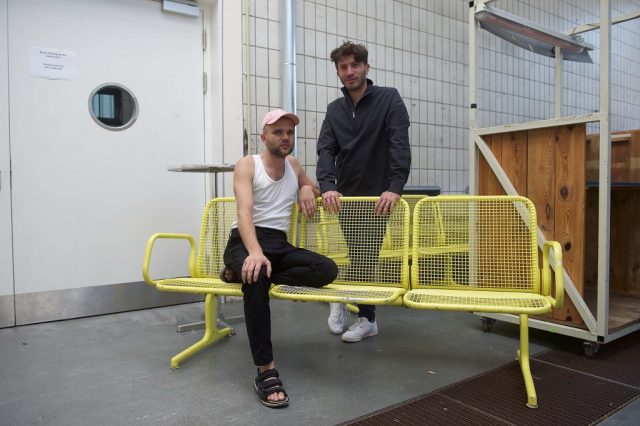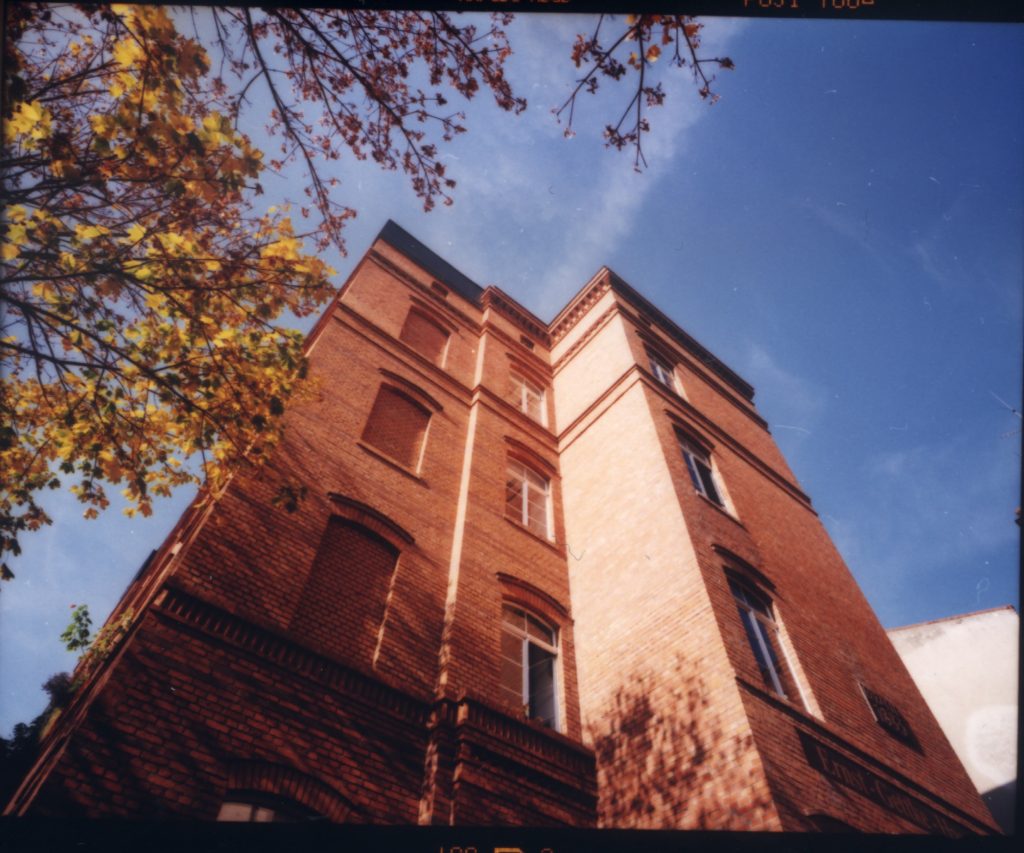
Incontriamo Jacopo Lanteri, direttore, insieme a Ludger Orlok, del dipartimento di produzione della Tanzfabrik Berlin e direttore, insieme a Julian Weber, del festival Tanznacht Berlin. La Tanzfabrik Berlin, rinomato centro di diffusione e produzione di danza contemporanea, è stata fondata nel 1978 in un’antica fabbrica di lampade, nella parte occidentale di Kreuzberg. L’edificio di mattoncini rossi in Möckernstraße 68, prima di diventare l’importante istituzione culturale che oggi tutti conosciamo, era occupato da artisti e studenti che lo utilizzavano come luogo di creazione e di esibizione. Negli anni ’90, poi, la Tanzfabrik è passata dalla produzione collettiva a una struttura con direzione artistica diventando un modello per la formazione, per la ricerca e la promozione della danza. Oggi, oltre alla sede storica a Kreuzberg, la Tanzfabrik Berlin dispone anche di due moderni Studi nel complesso degli Uferstudios a Wedding https://www.tanzfabrik-berlin.de/.
Per proseguire la nostra analisi circa i cambiamenti determinati dallo stato di pandemia e per comprendere, da un ulteriore punto di vista, gli effetti che la crisi ha avuto nell’ambito dell’arte e della cultura a Berlino, ho domandato a Jacopo Lanteri, la sua esperienza e le sue impressioni relative a questo delicato momento.
L’emergenza COVID-19 ha creato enormi problemi a quasi tutte le attività, tanto commerciali che culturali. Essendo state vietate per molto tempo le attività al chiuso e gli assembramenti, il mondo della danza e, più in generale, quello dell’arte sono stati particolarmente colpiti dalle misure restrittive adottate dai diversi Paesi. In considerazione dei divieti e dei regolamenti imposti, può dirmi in che modo è cambiata l’attività e l’organizzazione della Tanzfabrik?
Per quanto riguarda il dipartimento di produzione, fortunatamente, non ha subito grandi stravolgimenti. Durante il periodo di lock-down non avevamo spettacoli in programma, quindi abbiamo potuto dedicarci pienamente all’organizzazione dell’undicesima edizione della Tanznacht, il nostro festival biennale che quest’anno si terrà dal 9 al 13 settembre. Ovviamente, in ossequio ai regolamenti adottati per la pandemia, il Festival si svolgerà in parte all’aperto e in parte sotto forma di esposizione di oggetti, pratiche e performance.
La scuola di danza, invece, è stata molto più colpita dalle restrizioni anti Corona Virus. Durante il lock-down abbiamo organizzato corsi digitali. Sebbene la interazione e il contatto fisico siano condizioni essenziali per la danza, la possibilità di seguire lezioni on line ha messo in luce anche un aspetto positivo di questa emergenza, dando l’opportunità a persone geograficamente molto lontane di partecipare e seguire classi.
Cos’ha fatto il governo tedesco per supportare il lavoro di istituzioni legate alla danza?
In Germania gli aiuti, tanto ai privati – freelancers – che alle numerose associazioni culturali, sono stati provvidenziali. Nel nostro caso, il dipartimento della scuola Tanzfabrik ha ricevuto 14.000 euro più la possibilità di mettere in cassa integrazione i propri dipendenti.
Relativamente al dipartimento della Produzione, che lavora con un finanziamento pubblico di 400.000 euro annuali, non abbiamo ancora richiesto aiuti economici, soprattutto perché non abbiamo dovuto cancellare spettacoli o eventi già pianificati.
Per quanto sia stato importante il sostegno del governo, siamo anche riusciti, non senza una certa soddisfazione, ad assicurarci dei fondi supplementari per la nostra istituzione tramite un progetto sostenuto da Creative Europe, programma dell’Unione europea per i settori culturali e creativi. Il progetto internazionale dal titolo “apap – Feminist Futures”, con un Budget da 4 Milioni di Euro in 4 anni, prevede la cooperazione di 11 teatri di altrettanti Paesi europei, il nostro partner Italiano è Centrale Fies, con cui collaboriamo da diversi anni.
In Italia è da tempo iniziata la cosiddetta fase tre, anche se in realtà, almeno per quanto riguarda il mondo della danza, è soltanto ora che ci si confronta con i problemi organizzativi e pratici dovuti alle misure preventive adottate per evitare il diffondersi del virus. In che fase si è a Berlino?
Anche a Berlino, dalla metà di giugno, è stata data la possibilità di riprendere molte attività. Per quanto riguarda Tanzfabrik, l’offerta di classi di danza contemporanea è ripartita il primo luglio. La difficoltà è stata riorganizzare gli spazi per rispettare le regole relative alla distanza di sicurezza e all’uso delle mascherine.
Non pensa che la danza, soprattutto in considerazione del contatto fisico tra i ballerini, meriti una regolamentazione specifica e non un generico richiamo alle discipline sportive?
Se per la scuola ci si è dovuti rifare alle disposizioni riguardanti lo ‘sport’, per la parte della produzione i regolamenti da seguire sono quelli per gli enti culturali. Teatri e festival devono presentare un progetto che deve indicare come si intende garantire la sicurezza dei ballerini, dei tecnici e degli spettatori. In tal senso, alcune compagnie hanno fatto sottoporre i loro membri al test per riceve il permesso al contatto fisico.
Nel nostro caso, il progetto presentato per riaprire al pubblico con la Tanznacht, il prossimo settembre, dovrà essere approvato dal dipartimento della Salute della città di Berlino http://tanznachtberlin.de/tanznachtberlin2020/.
Dopo questo momento di emergenza sanitaria, crede che tutto ritorni a funzionare come prima o ci saranno delle differenze nel modo di lavorare di artisti, organizzazioni ed enti culturali?
Non credo che passata la pandemia si possa ritornare esattamente a lavorare come prima, come se niente fosse accaduto. Guardando al futuro, se alcuni cambiamenti costituiranno un limite in termini di interazione fisica, intravedo anche alcuni aspetti positivi che si potranno cogliere da questa esperienza. Come dicevo, l’offerta digitale ha portato un’apertura a fasce di pubblico che, per ragioni logistiche, prima non potevano godere delle nostre offerte didattiche. Per quanto riguarda la produzione artistica, sarà un occasione per rivedere la posizione dell’artista nella società, per trovare nuove forme espressive e nuovi tipi di collaborazioni.

Jacopo, grazie mille per le sue risposte, congratulazione per i successi di Tanzfabrik e in bocca al lupo per la Tanznacht e Feminist Futures.
Tanzfabrik Berlin, a renowned center for the diffusion and production of contemporary dance, was founded in 1978 in an old lamp factory in the western part of Kreuzberg. Before becoming the important cultural institution that we all know today, the famous red brick building on Möckernstraße 68 was occupied by artists and students who used it as a place of creation and exhibition. In the 90s, the Tanzfabrik went from collective production to a structure with artistic direction. In that way became a model for dance training, research and promotion. Today, in addition to the historic headquarters in Kreuzberg, Tanzfabrik Berlin also has two modern studios at Uferstudios in Wedding https://www.tanzfabrik-berlin.de/.
To continue our analysis of the changes caused by the pandemic and to understand, from a further point of view, the effects that the crisis has had in the Berlin’s arts and culture field, I asked to Jacopo Lanteri, Tanzfabrik Berlin production department director, together with Ludger Orlok, and Tanznacht Berlin festival director, together with Julian Weber, his experience and impressions relating to this delicate moment.
The COVID-19 emergency has created enormous problems for almost all businesses, both commercial and cultural. Since indoor activities and gatherings have been banned for a long time, the dance world and the arts world in general, have been particularly affected by the restrictive measures adopted by different countries. Considering the prohibitions and regulations imposed, can you tell me how the Tanzfabrik activity and organization had changed?
As a production center, we haven’t undergone major upheavals. During the lock-down period we had no shows scheduled, so we were able to fully dedicate ourselves to the organization of the eleventh edition of Tanznacht, our biennial festival that this year will be held from the 9thto the 13th September. Obviously, according to the regulations adopted for the pandemic, the Festival will take place partly outdoors and partly indoors as if it were an objects, practices and performances exhibition.
The dance school, on the other hand, has been much more affected by the anti-virus restrictions. During the lock-down we organized digital courses. Although interaction and physical contact are essential conditions for dance, the possibility of attending online lessons has also highlighted a positive aspect of this emergency, giving the opportunity to people who were geographically distant, to participate and follow classes from different countries.
What has the German government done to support the work of dance institutions?
In Germany, aid, to freelancers and to the several cultural associations, was providential. In our case, Tanzfabrik’ school department received 14.000 euros plus the opportunity to lay off its employees. For our production department, which works with a public funding of 400.000 Euros per year, we haven’t requested financial aid, especially due to the fact that we didn’t need to cancel shows or events.
As important as government support has been, we have also managed to secure additional funds for our institution through a project supported by Creative Europe, the European Union’s program for the cultural and creative sectors. The international project entitled “apap – Feminist Futures”, with a budget of 4 million Euros in 4 years, involves the cooperation of 11 theatres from as many different countries. Our Italian partner is Centrale Fies, with whom we have been collaborating for several years.
In Italy, the so-called phase three began a long time ago, although in reality, at least as it regards to the dance world, it is only now that we are confronted with the organizational and practical problems due to the preventive measures adopted to avoid the spread of the virus. What stage are you in in Berlin?
Also in Berlin, from mid-June, the possibility of resuming many activities was given. As regards Tanzfabrik, the resumption of our contemporary dance classes restarted on July 1st. The difficulty was to rearrange the spaces to comply with the rules relating to the safety distance and the use of the masks.
Don’t you think that dance, especially in consideration of the physical contact between the dancers, deserves specific regulation and not a generic reference to sports disciplines?
If Tanzfabrik as school had to refer to the provisions relating to ‘sport’, as production center the regulations to be followed were those for cultural organizations. Theatres and festivals must present a project that must indicate how the safety of dancers, technicians and spectators is intended. In this sense, some dance companies have had their members tested for receiving permission for physical contact. In our case, the project presented for Tanznacht must be approved by the Berlin Health Department http://tanznachtberlin.de/tanznachtberlin2020/.
Do you think that after this moment of sanitary emergency everything will return as before or will there be differences in the way of working in artistic and cultural organizations?
I don’t think that after the pandemic we can go back to work exactly as before. Looking to the future, if some changes will constitute a limit in terms of physical interaction, I also foresee some positive aspects that can be grasped from this experience. As I said, the digital offer has brought an opening to audiences who, for logistical reasons, previously could not enjoy our educational offers. About the artistic production, it will be an opportunity to review the artist’s position in society, to find new forms of expression and new types of collaborations.














































